Education Strategies: Simple Ways to Boost Learning
Looking for ways to make learning easier and more fun? You don’t need a fancy plan – just a handful of practical tricks you can start using right now. Whether you’re a parent, teacher, or adult learner, these strategies work in the classroom, at home, and even on the go.
Everyday techniques for kids
Kids respond best to activities that let them move, talk, and explore. Try turning a lesson into a game: use a timer for a quick “find the letter” hunt or swap a worksheet for a hands‑on puzzle. When a child can see or touch the concept, it sticks better. Short, focused sessions (10‑15 minutes) keep attention high without causing fatigue.
Another easy trick is to link new ideas to something the child already loves. If they’re into dinosaurs, use dinosaur footprints to teach counting, or read a story about a brave dino to discuss emotions. Connecting learning to personal interests makes the material feel relevant and boosts confidence.
Don’t forget the power of praise. Be specific – say, “You matched the shapes perfectly,” instead of a generic “Good job.” Specific feedback shows the child what they did right and encourages them to repeat the behavior. Pair praise with a quick recap of the lesson to reinforce the key point.
Adult learning tricks you can use too
Adults learn best when they see immediate value. Start any new skill by answering the question, “How will this help me right now?” For example, if you’re picking up a certification, identify the real‑world task it will simplify and practice that first. This problem‑focused approach mirrors the key principle of adult learning – self‑direction paired with relevance.
Break bigger topics into bite‑size chunks. Use the 1247 rule: study for 12 minutes, take a 1‑minute break, then review for 4 minutes, and finish with a 7‑minute recap. This rhythm keeps the brain active without overload and works for everything from language learning to tech certifications.
Visual learners benefit from quick sketches or mind maps, auditory learners from short recordings, and kinesthetic learners from short, hands‑on tasks. Pick the style that fits you for each topic and you’ll retain more, faster. Experiment with a mix – sometimes a quick doodle alongside a brief audio summary does the trick.
Finally, schedule a regular “reflection hour.” Spend 10 minutes after a study session noting what worked, what didn’t, and what you’ll try next time. This habit turns every learning experience into a stepping stone for the next one, keeping progress steady and purposeful.
These simple education strategies don’t require expensive tools or endless planning. By adding a game, linking to interests, giving clear feedback for kids, and using relevance, bite‑size chunks, and reflection for adults, you create a learning environment that’s engaging, effective, and enjoyable. Give them a try today and watch confidence grow across ages.
Best Training for Teachers: Tips and Insights
In today's fast-paced education landscape, finding the best training for teachers is crucial for nurturing effective educators. This article explores different training methods and highlights practical tips on how teachers can enhance their skills and better connect with students. From classroom management to digital tools, discover strategies that make teaching impactful and rewarding. Uncover insights on customizing training to fit diverse learning environments and personal growth.
Breaking the Barriers: Adult Learning Challenges and Strategies
Exploring why adults face hurdles in learning is essential to understanding the broader implications of adult education. Adults often struggle due to factors such as ingrained habits, anxiety, and time constraints. This article uncovers key reasons behind these challenges while offering practical strategies to help adults navigate the learning process. By embracing flexibility and leveraging supportive tools, adult learners can successfully overcome educational barriers and achieve their learning goals.

